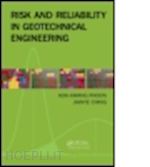Part I Properties Constructing multivariate distributions for soil parameters; Jianye Ching and Kok-Kwang Phoon Introduction Normal random variable Bivariate normal vector Multivariate normal vector Non-normal random variable Multivariate non-normal random vector Real example Future challenges List of symbols References Modeling and simulation of bivariate distribution of shear strength parameters using copulas; Dian-Qing Li and Xiao-Song Tang Introduction Copula theory Modeling bivariate distribution of shear strength parameters Simulating bivariate distribution of shear strength parameters Impact of copula selection on retaining wall reliability Summary and conclusions Acknowledgments Appendix 2.1: MATLAB® codes List of symbols References Part II Methods Evaluating reliability in geotechnical engineering; J. Michael Duncan and Matthew D. Sleep Purpose of reliability analysis Probability of failure and risk Language of statistics and probability Probability of failure and factor of safety Methods of estimating standard deviations Computing probability of failure Monte Carlo analysis using @Risk™ Hasofer Lind method Taylor Series method with assumed normal distribution of the factor of safety Taylor Series method with a lognormal distribution of the factor of safety PEM with a normal distribution for the factor of safety PEM with a lognormal distribution for the factor of safety Comments on the methods Summary References Maximum likelihood principle and its application in soil liquefaction assessment; Charng Hsein Juang, Sara Khoshnevisan, and Jie Zhang Introduction Principle of maximum likelihood Liquefaction probability based on generalized linear regression Converting a deterministic liquefaction model into a probabilistic model Estimation of liquefaction-induced settlement Summary and Conclusions Acknowledgments Appendix 4.1: Model of Robertson and Wride (1998) and Robertson (2009) Appendix 4.2: Notation References Bayesian analysis for learning and updating geotechnical parameters and models with measurements; Daniel Straub and Iason Papaioannou Introduction Bayesian analysis Geotechnical reliability based on measurements: Step-by-step procedure for Bayesian analysis Advanced algorithms for efficient and effective Bayesian updating of geotechnical models Application: Foundation of transmission towers under tensile loading Application: Finite-element-based updating of soil parameters and reliability Concluding remarks Acknowledgment References Polynomial chaos expansions and stochastic finite-element methods; Bruno Sudret Introduction Uncertainty propagation framework Polynomial chaos expansions Postprocessing for engineering applications Sensitivity analysis Application examples Conclusions Acknowledgments Appendix 6.1: List of symbols Appendix 6.2: Hermite polynomials References Practical reliability analysis and design by Monte Carlo Simulation in spreadsheet; Yu Wang and Zijun Cao Introduction Subset Simulation Expanded RBD with Subset Simulation Probabilistic failure analysis using Subset Simulation Spreadsheet implementation of MCS-based reliability analysis and design Illustrative example I: Drilled shaft design Illustrative example II: James Bay Dike design scenario Summary and concluding remarks Acknowledgment List of symbols References Part III Design LRFD calibration of simple limit state functions in geotechnical soil-structure design; Richard J. Bathurst Introduction Preliminaries Bias value distributions Calculation of ß, ?Q, and f Example Additional considerations Conclusions References Reliability-based design: Practical procedures, geotechnical examples, and insights; Bak-Kong Low Introduction Example of reliability-based shallow foundation design SORM analysis on the foundation of FORM results for a rock slope Probabilistic analyses of a slope failure in San Francisco Bay mud Reliability analysis of a Norwegian slope accounting for spatial autocorrelation System FORM reliability analysis of a soil slope with two equally likely failure modes Multicriteria RBD of a laterally loaded pile in spatially autocorrelated clay FORM design of an anchored sheet pile wall Reliability analysis of roof wedges and rockbolt forces in tunnels Probabilistic settlement analysis of a Hong Kong trial embankment on soft clay Coupling of stand-alone deterministic program and spreadsheetautomated reliability procedures via response surface or similar methods Summary and conclusions References Managing risk and achieving reliable geotechnical designs using Eurocode 7; Trevor L.L. Orr Introduction Geotechnical complexity and risk Reliability requirements in designs to Eurocode 7 Verification of designs to Eurocode 7 Reliability levels Conclusions Acknowledgments References Part IV Risk and decision Practical risk assessment for embankments, dams, and slopes; Luis Altarejos-García, Francisco Silva-Tulla, Ignacio Escuder-Bueno, and Adrián Morales-Torres Introduction Estimation of conditional probability as a function of safety factor Role of fragility curves to evaluate the uncertainty in probability estimates Mathematical roots and numerical estimation of fragility curves From fragility curves to annualized probability of failure commonly used in risk analysis Summary of main points Acknowledgments List of main symbols and acronyms References Evolution of geotechnical risk analysis in North American practice; Gregory B. Baecher and John T. Christian Introduction Beginnings Geotechnical reliability (1971–1996) Mining engineering (1969–1980) Offshore reliability (1974–1990) Environmental remediation (1980–1995) Dam safety (1986–Ongoing) Systems risk assessment (2005–Ongoing) Emerging approaches: System simulation, stress testing, and scenario appraisals Ten unresolved questions Concluding thoughts Acknowledgments References Assessing the value of information to design site investigation and construction quality assurance programs; Robert B. Gilbert and Mahdi Habibi Introduction Value of information framework Insights from Bayes’ theorem Implementation of value of information assessment Case-history applications Summary Acknowledgments References Verification of geotechnical reliability using load tests and integrity tests; Limin Zhang Introduction Within-site variability of pile capacity Updating pile capacity with proof load tests Updating pile capacity with integrity tests Reliability of piles verified by proof load tests Reliability of piles verified by integrity tests Summary Acknowledgment List of symbols References Part V Spatial variability Application of the subset simulation approach to spatially varying soils; Ashraf Ahmed and Abdul-Hamid Soubra Introduction Karhunen–Loève expansion methodology for the discretization of a random field Brief overview of the subset simulation approach Method of computation of the failure probability by the SS approach in the case of a spatially varying soil property Example applications Conclusion Appendix 15.1: Modified M–H algorithm List of symbols References Index












